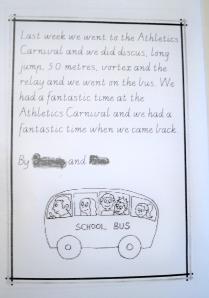
Yesterday was the very first day of formal education for 21 students in my Prep grade. They arrived with their parents, some grandparents and special others to celebrate the beginning of their 13 year journey (Prep to Year 12). After photos and goodbyes the parents and special others left leaving their most precious little people to start their journey.
Organisation and self management starts day one in our classroom. After settling the children, we talked about how we organise ourselves. Firstly, our belongings. The children produced their full schools bags and were shown where to put their lunch boxes, drink bottles, message bags, library bags and art smocks. They were then given a plain sticker to write their name on in bright colors. This sticker was placed where they will keep their bag. They will name all their books the same way. You will not walk into my classroom and find name tags pre made and placed. My children name all their belongings themselves and learn where they are to keep them. They had a name card to copy from if they were unsure. Most just wrote their name or something like it. It doesn’t matter because they know their sticker.
This morning the children arrived for their second day and promptly started unpacking their bag and placing everything where they were shown. Only one parent started to unpack their child’s bag and quickly stopped when I gently reminded her that her child knew where to put everything. These children are very capable of managing themselves when given the opportunity. The children will also be having an afternoon when they will invite their parents into the classroom to show how we organise our classroom and how they organise themselves. I have also set up our classroom, which isn’t as big as my room last year with two distinct learning areas for the children to sit. They now know where ever I sit, they sit in front of me. This gives those restless young children an opportunity to move and refocus. This really does work and I’ll include some photos next week. Each area has a different focus and teaching aids ready to use.
Our day started with our reading of Big Books ( I have my favourites ) which involve movement and chant. We looked at sentences, words and letters. As we are introducing THRASS as a strategy for teaching spelling, I introduced the chart. We started to get to know letter names and the sounds they make in certain words. Connections were being made, new words discovered and engagement was evident. These children are desperate to learn, they want to get going!
I asked a child want they really wanted to try and it was writing and reading. Perfect! We can do that… My teaching approach is Language Experience, so we talked about something we were all doing together and I got the answer I was looking for. They were all at school. I asked for a sentence. One child said, ‘I am at school.’ Once again this was the sentence I wanted. I then asked if anyone knew what an ‘ I ‘ looked like. Hands went up and a child came up to the board and wrote ‘I’. We were off and going strong. I showed them my hand signal for I and now they could read a word. The next word was ‘am’ , we stretched it out, listened to the sounds letters made in this word, looked at our chart, chanted it and had a think about what it might look like. They could tell me the initial sound ‘a’, so once again a child came up and wrote an ‘a’. As the children have had no handwriting lessons I urge them to ‘have a go’ and write what they think represents the sound. It was interesting to note that the child looked at the THRASS chart. I introduced spaces between words, a capital letter and full stop. It doesn’t matter if they don’t remember, it’s the start and these ‘concepts of print’are explained over and over.
We continued until, as a grade we had written the sentence. Amazing! Their sentence was then put on a sentence strip, cut up and placed in our sentence strip board. This will be the first sentence in our first ‘Language Experience’ little book which will become a ‘take home’ book. We played games with the words which they loved. With technology at my finger tip, I was able to type their sentence for them to trace, copy and illustrate. They really needed some table time to complete a task and enjoy producing something for their ‘I am at school’ poster. Each child read the sentence to me. We’re reading and writing, problem solving and engaged.
 ‘ poster.
‘ poster.

Cheers Nina
P.S Jacinta, if you read this post. I’ll be catching up soon and hope your first week of teaching has been wonderful.


























































 As I write my student’s reports I can’t help but reflect upon my teaching and my student’s learning. What can I do better and what is going well? My blog helps me to reflect on, and improve my practice.
As I write my student’s reports I can’t help but reflect upon my teaching and my student’s learning. What can I do better and what is going well? My blog helps me to reflect on, and improve my practice.



